Electrical Engineering: Comprehensive Work Experience Report
VerifiedAdded on 2020/03/04
|13
|3846
|996
Report
AI Summary
This report provides a detailed account of an electrical engineer's work experience, encompassing practical application of theoretical knowledge, project involvement, and engineering management. The engineer discusses their role in analyzing, designing, and implementing electrical systems across various projects, including power distribution, lighting, and equipment installations. The report highlights the application of analytical techniques, design methodologies, and testing procedures. The engineer also emphasizes the importance of practical experience, including site visits, equipment operation, and troubleshooting. Challenges encountered during project implementation are also addressed, along with the engineer's approach to problem-solving and conflict resolution. The report showcases the engineer's ability to manage projects, communicate effectively, and contribute to team success, demonstrating a comprehensive understanding of electrical engineering principles and practices. The report is a valuable resource for students studying electrical engineering and looking for examples of practical applications of the subject.
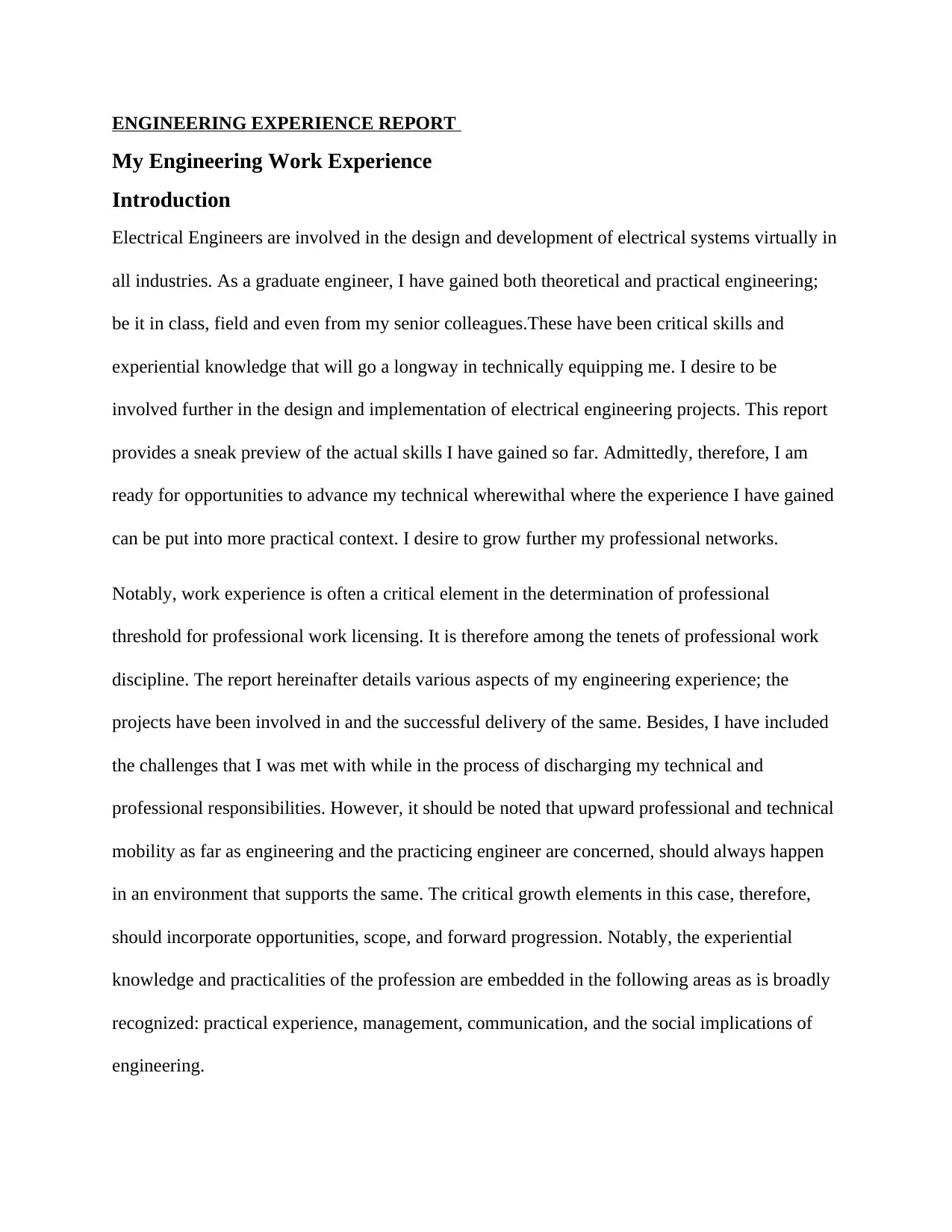
ENGINEERING EXPERIENCE REPORT
My Engineering Work Experience
Introduction
Electrical Engineers are involved in the design and development of electrical systems virtually in
all industries. As a graduate engineer, I have gained both theoretical and practical engineering;
be it in class, field and even from my senior colleagues.These have been critical skills and
experiential knowledge that will go a longway in technically equipping me. I desire to be
involved further in the design and implementation of electrical engineering projects. This report
provides a sneak preview of the actual skills I have gained so far. Admittedly, therefore, I am
ready for opportunities to advance my technical wherewithal where the experience I have gained
can be put into more practical context. I desire to grow further my professional networks.
Notably, work experience is often a critical element in the determination of professional
threshold for professional work licensing. It is therefore among the tenets of professional work
discipline. The report hereinafter details various aspects of my engineering experience; the
projects have been involved in and the successful delivery of the same. Besides, I have included
the challenges that I was met with while in the process of discharging my technical and
professional responsibilities. However, it should be noted that upward professional and technical
mobility as far as engineering and the practicing engineer are concerned, should always happen
in an environment that supports the same. The critical growth elements in this case, therefore,
should incorporate opportunities, scope, and forward progression. Notably, the experiential
knowledge and practicalities of the profession are embedded in the following areas as is broadly
recognized: practical experience, management, communication, and the social implications of
engineering.
My Engineering Work Experience
Introduction
Electrical Engineers are involved in the design and development of electrical systems virtually in
all industries. As a graduate engineer, I have gained both theoretical and practical engineering;
be it in class, field and even from my senior colleagues.These have been critical skills and
experiential knowledge that will go a longway in technically equipping me. I desire to be
involved further in the design and implementation of electrical engineering projects. This report
provides a sneak preview of the actual skills I have gained so far. Admittedly, therefore, I am
ready for opportunities to advance my technical wherewithal where the experience I have gained
can be put into more practical context. I desire to grow further my professional networks.
Notably, work experience is often a critical element in the determination of professional
threshold for professional work licensing. It is therefore among the tenets of professional work
discipline. The report hereinafter details various aspects of my engineering experience; the
projects have been involved in and the successful delivery of the same. Besides, I have included
the challenges that I was met with while in the process of discharging my technical and
professional responsibilities. However, it should be noted that upward professional and technical
mobility as far as engineering and the practicing engineer are concerned, should always happen
in an environment that supports the same. The critical growth elements in this case, therefore,
should incorporate opportunities, scope, and forward progression. Notably, the experiential
knowledge and practicalities of the profession are embedded in the following areas as is broadly
recognized: practical experience, management, communication, and the social implications of
engineering.
Paraphrase This Document
Need a fresh take? Get an instant paraphrase of this document with our AI Paraphraser
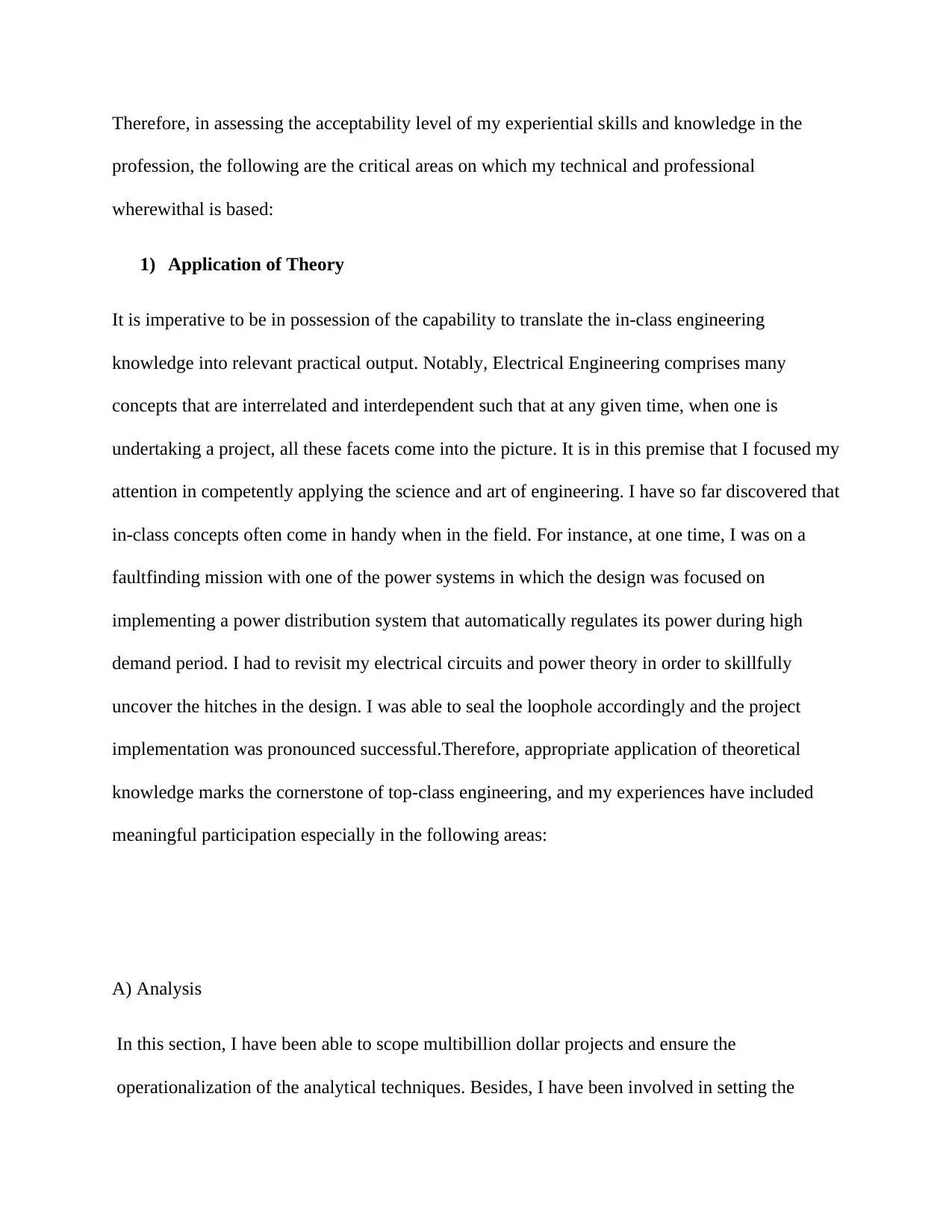
Therefore, in assessing the acceptability level of my experiential skills and knowledge in the
profession, the following are the critical areas on which my technical and professional
wherewithal is based:
1) Application of Theory
It is imperative to be in possession of the capability to translate the in-class engineering
knowledge into relevant practical output. Notably, Electrical Engineering comprises many
concepts that are interrelated and interdependent such that at any given time, when one is
undertaking a project, all these facets come into the picture. It is in this premise that I focused my
attention in competently applying the science and art of engineering. I have so far discovered that
in-class concepts often come in handy when in the field. For instance, at one time, I was on a
faultfinding mission with one of the power systems in which the design was focused on
implementing a power distribution system that automatically regulates its power during high
demand period. I had to revisit my electrical circuits and power theory in order to skillfully
uncover the hitches in the design. I was able to seal the loophole accordingly and the project
implementation was pronounced successful.Therefore, appropriate application of theoretical
knowledge marks the cornerstone of top-class engineering, and my experiences have included
meaningful participation especially in the following areas:
A) Analysis
In this section, I have been able to scope multibillion dollar projects and ensure the
operationalization of the analytical techniques. Besides, I have been involved in setting the
profession, the following are the critical areas on which my technical and professional
wherewithal is based:
1) Application of Theory
It is imperative to be in possession of the capability to translate the in-class engineering
knowledge into relevant practical output. Notably, Electrical Engineering comprises many
concepts that are interrelated and interdependent such that at any given time, when one is
undertaking a project, all these facets come into the picture. It is in this premise that I focused my
attention in competently applying the science and art of engineering. I have so far discovered that
in-class concepts often come in handy when in the field. For instance, at one time, I was on a
faultfinding mission with one of the power systems in which the design was focused on
implementing a power distribution system that automatically regulates its power during high
demand period. I had to revisit my electrical circuits and power theory in order to skillfully
uncover the hitches in the design. I was able to seal the loophole accordingly and the project
implementation was pronounced successful.Therefore, appropriate application of theoretical
knowledge marks the cornerstone of top-class engineering, and my experiences have included
meaningful participation especially in the following areas:
A) Analysis
In this section, I have been able to scope multibillion dollar projects and ensure the
operationalization of the analytical techniques. Besides, I have been involved in setting the
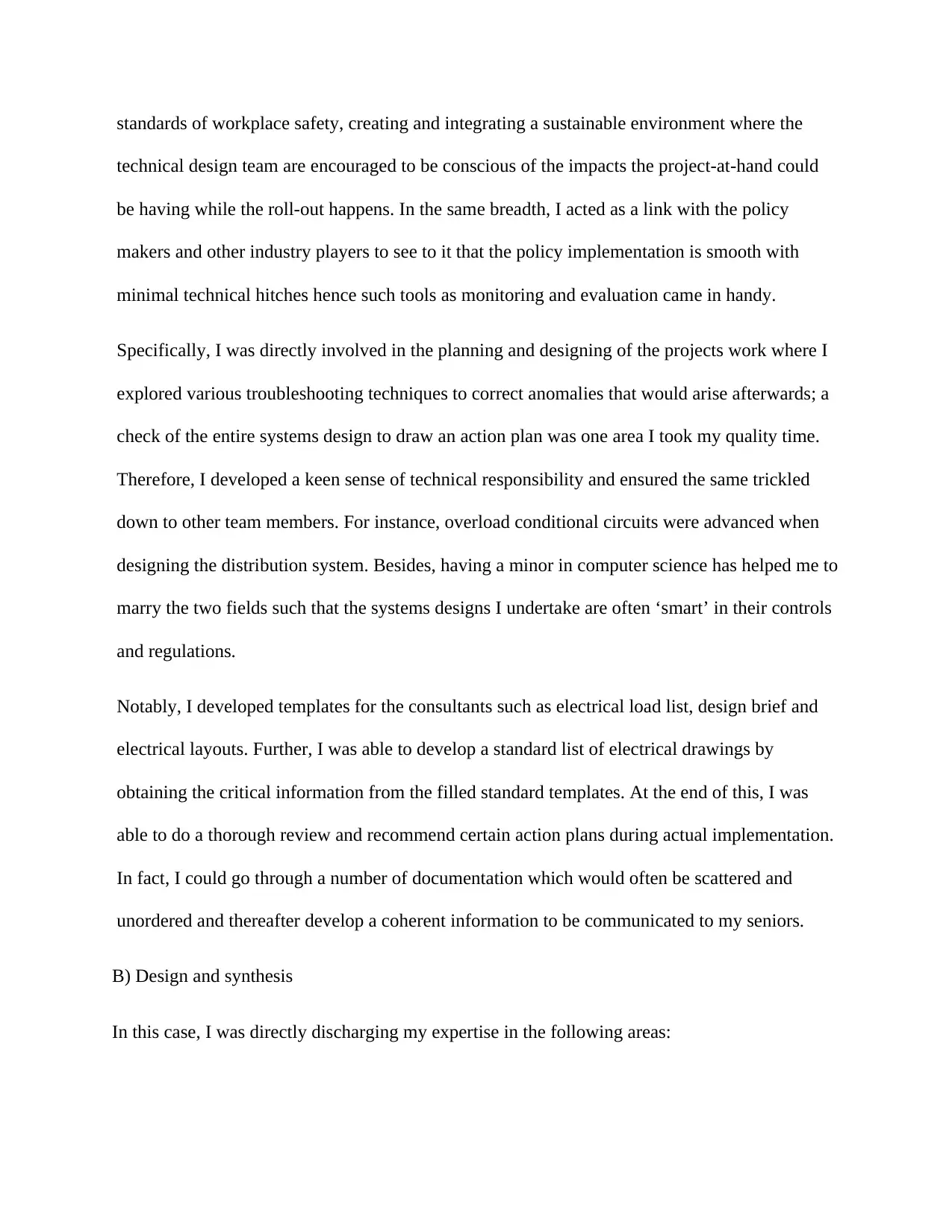
standards of workplace safety, creating and integrating a sustainable environment where the
technical design team are encouraged to be conscious of the impacts the project-at-hand could
be having while the roll-out happens. In the same breadth, I acted as a link with the policy
makers and other industry players to see to it that the policy implementation is smooth with
minimal technical hitches hence such tools as monitoring and evaluation came in handy.
Specifically, I was directly involved in the planning and designing of the projects work where I
explored various troubleshooting techniques to correct anomalies that would arise afterwards; a
check of the entire systems design to draw an action plan was one area I took my quality time.
Therefore, I developed a keen sense of technical responsibility and ensured the same trickled
down to other team members. For instance, overload conditional circuits were advanced when
designing the distribution system. Besides, having a minor in computer science has helped me to
marry the two fields such that the systems designs I undertake are often ‘smart’ in their controls
and regulations.
Notably, I developed templates for the consultants such as electrical load list, design brief and
electrical layouts. Further, I was able to develop a standard list of electrical drawings by
obtaining the critical information from the filled standard templates. At the end of this, I was
able to do a thorough review and recommend certain action plans during actual implementation.
In fact, I could go through a number of documentation which would often be scattered and
unordered and thereafter develop a coherent information to be communicated to my seniors.
B) Design and synthesis
In this case, I was directly discharging my expertise in the following areas:
technical design team are encouraged to be conscious of the impacts the project-at-hand could
be having while the roll-out happens. In the same breadth, I acted as a link with the policy
makers and other industry players to see to it that the policy implementation is smooth with
minimal technical hitches hence such tools as monitoring and evaluation came in handy.
Specifically, I was directly involved in the planning and designing of the projects work where I
explored various troubleshooting techniques to correct anomalies that would arise afterwards; a
check of the entire systems design to draw an action plan was one area I took my quality time.
Therefore, I developed a keen sense of technical responsibility and ensured the same trickled
down to other team members. For instance, overload conditional circuits were advanced when
designing the distribution system. Besides, having a minor in computer science has helped me to
marry the two fields such that the systems designs I undertake are often ‘smart’ in their controls
and regulations.
Notably, I developed templates for the consultants such as electrical load list, design brief and
electrical layouts. Further, I was able to develop a standard list of electrical drawings by
obtaining the critical information from the filled standard templates. At the end of this, I was
able to do a thorough review and recommend certain action plans during actual implementation.
In fact, I could go through a number of documentation which would often be scattered and
unordered and thereafter develop a coherent information to be communicated to my seniors.
B) Design and synthesis
In this case, I was directly discharging my expertise in the following areas:
⊘ This is a preview!⊘
Do you want full access?
Subscribe today to unlock all pages.

Trusted by 1+ million students worldwide
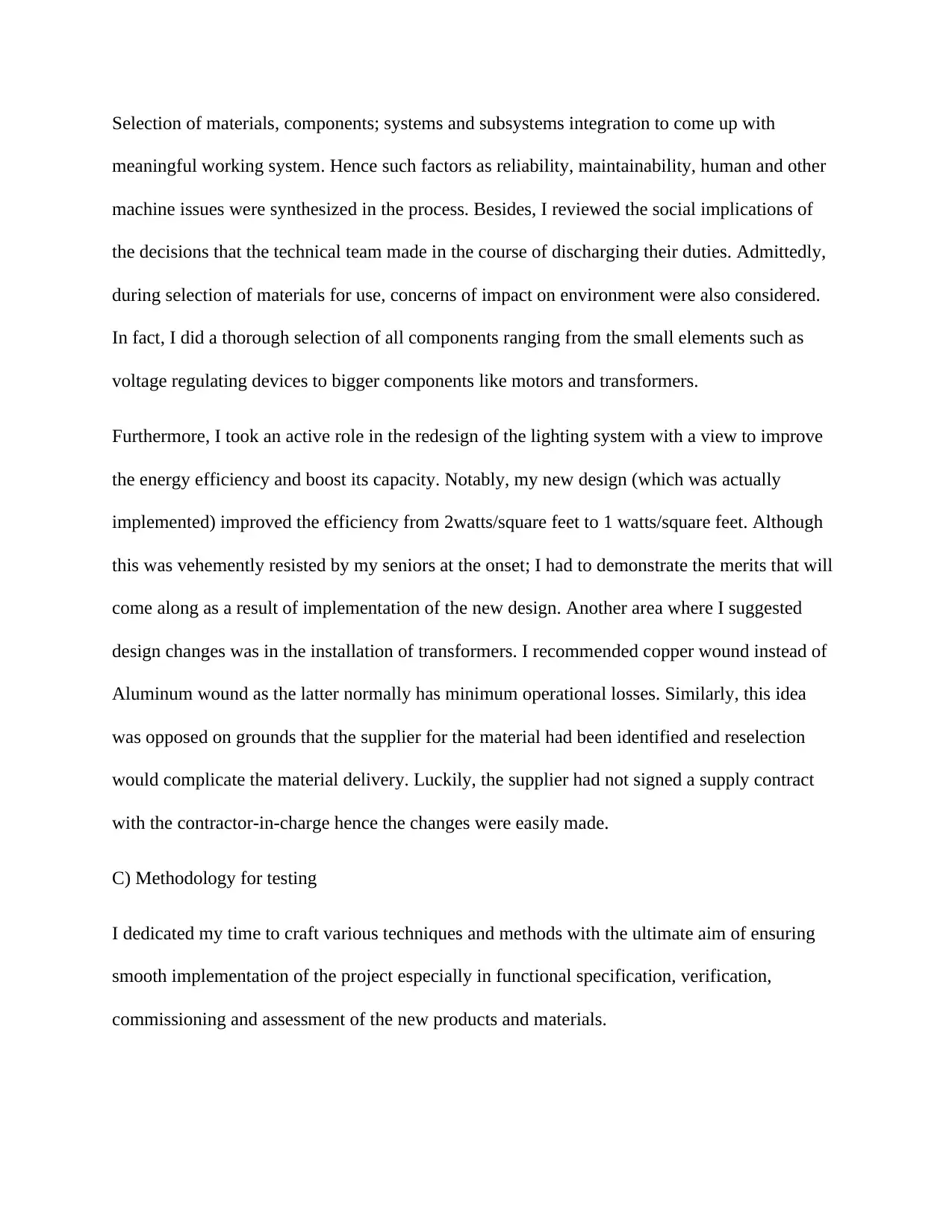
Selection of materials, components; systems and subsystems integration to come up with
meaningful working system. Hence such factors as reliability, maintainability, human and other
machine issues were synthesized in the process. Besides, I reviewed the social implications of
the decisions that the technical team made in the course of discharging their duties. Admittedly,
during selection of materials for use, concerns of impact on environment were also considered.
In fact, I did a thorough selection of all components ranging from the small elements such as
voltage regulating devices to bigger components like motors and transformers.
Furthermore, I took an active role in the redesign of the lighting system with a view to improve
the energy efficiency and boost its capacity. Notably, my new design (which was actually
implemented) improved the efficiency from 2watts/square feet to 1 watts/square feet. Although
this was vehemently resisted by my seniors at the onset; I had to demonstrate the merits that will
come along as a result of implementation of the new design. Another area where I suggested
design changes was in the installation of transformers. I recommended copper wound instead of
Aluminum wound as the latter normally has minimum operational losses. Similarly, this idea
was opposed on grounds that the supplier for the material had been identified and reselection
would complicate the material delivery. Luckily, the supplier had not signed a supply contract
with the contractor-in-charge hence the changes were easily made.
C) Methodology for testing
I dedicated my time to craft various techniques and methods with the ultimate aim of ensuring
smooth implementation of the project especially in functional specification, verification,
commissioning and assessment of the new products and materials.
meaningful working system. Hence such factors as reliability, maintainability, human and other
machine issues were synthesized in the process. Besides, I reviewed the social implications of
the decisions that the technical team made in the course of discharging their duties. Admittedly,
during selection of materials for use, concerns of impact on environment were also considered.
In fact, I did a thorough selection of all components ranging from the small elements such as
voltage regulating devices to bigger components like motors and transformers.
Furthermore, I took an active role in the redesign of the lighting system with a view to improve
the energy efficiency and boost its capacity. Notably, my new design (which was actually
implemented) improved the efficiency from 2watts/square feet to 1 watts/square feet. Although
this was vehemently resisted by my seniors at the onset; I had to demonstrate the merits that will
come along as a result of implementation of the new design. Another area where I suggested
design changes was in the installation of transformers. I recommended copper wound instead of
Aluminum wound as the latter normally has minimum operational losses. Similarly, this idea
was opposed on grounds that the supplier for the material had been identified and reselection
would complicate the material delivery. Luckily, the supplier had not signed a supply contract
with the contractor-in-charge hence the changes were easily made.
C) Methodology for testing
I dedicated my time to craft various techniques and methods with the ultimate aim of ensuring
smooth implementation of the project especially in functional specification, verification,
commissioning and assessment of the new products and materials.
Paraphrase This Document
Need a fresh take? Get an instant paraphrase of this document with our AI Paraphraser

D) Implementation methods where I looked into the real time application of technology
especially in performing cost-benefit analysis; process flow optimization, quality management,
safety and environmental issues and recommendations, and maintenance and replacement
evaluation among others.
Besides, I prepared technical and commercial bidding documents for Tata Consultancy Services.
I did the Interior floor design plans, rack positioning and various layouts of electrical systems.
Typically, I would be called upon to design the electrical circuits of the building services such as
HVAC systems, Fire Prevention units among others.
Furthermore, I devised and approved the switch gear testing and inspection where I carried out
insulation resistance tests. Actually, due to the architectural changes that were made in the course
of the project planning, I had to effect some realignments such as the introduction of cable
trays( which was actually not in the budget). I convinced the contractor-in-charge of the need to
provide cable gland plate and cable trays for the termination of the cables.
2) Practical Experience
Now, the second facet of my engineering experience is the practical aspects and this included
conducting field walkdowns; installing, testing, commissioning and operating the systems
involved. It should be noted that practical experience allows applicants to understand the
practical limitations of real systems. Therefore, in a nutshell, my practical experience included:
A) Visiting the sites to check on the continuing engineering works, with opportunities to
oversee equipment and systems in both operational and maintenance circumstances;
For instance, in the Intercontinental Hotel project in Abu Dhabi I was able to introduce
analytical tools to anticipate how risks and opportunities could be scoped. I also took part in
especially in performing cost-benefit analysis; process flow optimization, quality management,
safety and environmental issues and recommendations, and maintenance and replacement
evaluation among others.
Besides, I prepared technical and commercial bidding documents for Tata Consultancy Services.
I did the Interior floor design plans, rack positioning and various layouts of electrical systems.
Typically, I would be called upon to design the electrical circuits of the building services such as
HVAC systems, Fire Prevention units among others.
Furthermore, I devised and approved the switch gear testing and inspection where I carried out
insulation resistance tests. Actually, due to the architectural changes that were made in the course
of the project planning, I had to effect some realignments such as the introduction of cable
trays( which was actually not in the budget). I convinced the contractor-in-charge of the need to
provide cable gland plate and cable trays for the termination of the cables.
2) Practical Experience
Now, the second facet of my engineering experience is the practical aspects and this included
conducting field walkdowns; installing, testing, commissioning and operating the systems
involved. It should be noted that practical experience allows applicants to understand the
practical limitations of real systems. Therefore, in a nutshell, my practical experience included:
A) Visiting the sites to check on the continuing engineering works, with opportunities to
oversee equipment and systems in both operational and maintenance circumstances;
For instance, in the Intercontinental Hotel project in Abu Dhabi I was able to introduce
analytical tools to anticipate how risks and opportunities could be scoped. I also took part in
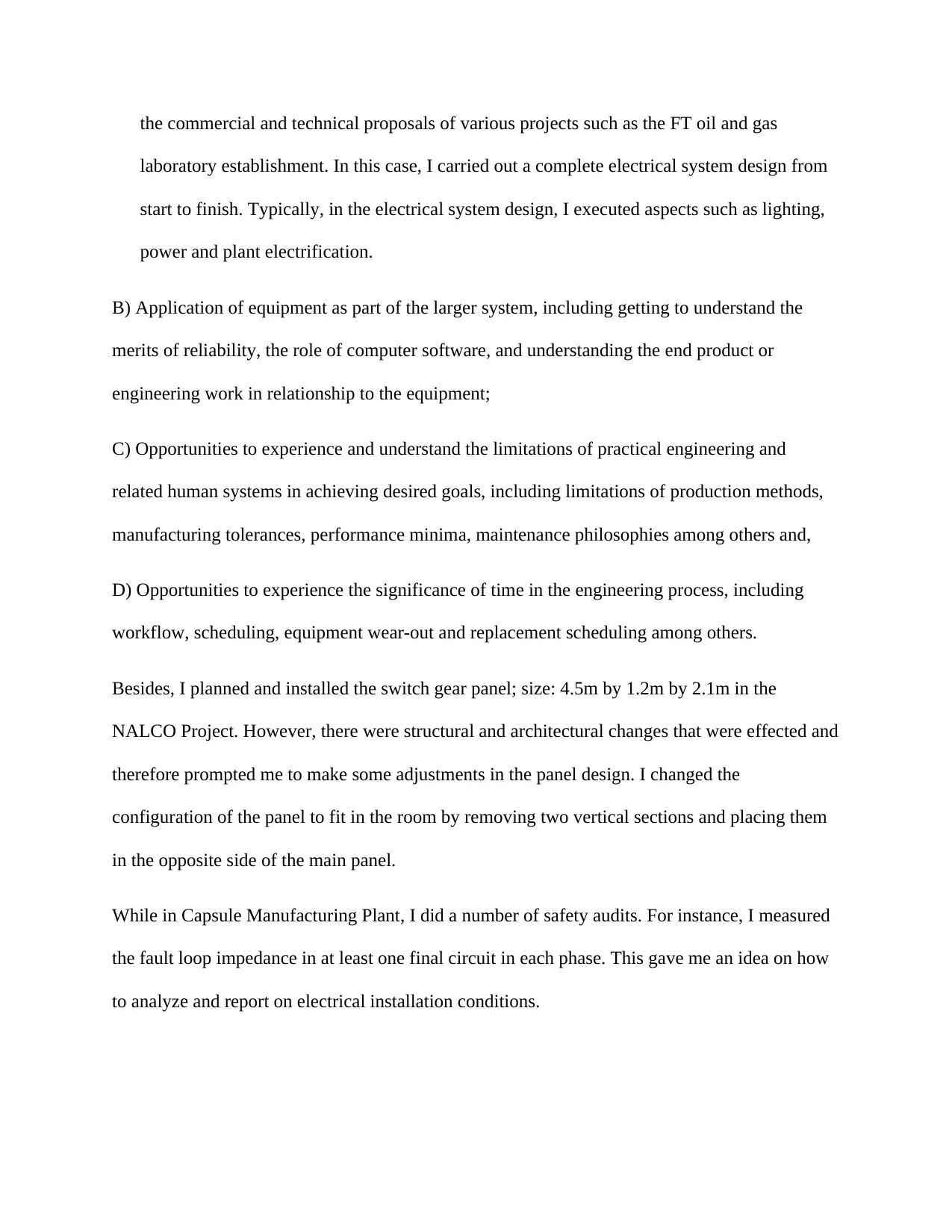
the commercial and technical proposals of various projects such as the FT oil and gas
laboratory establishment. In this case, I carried out a complete electrical system design from
start to finish. Typically, in the electrical system design, I executed aspects such as lighting,
power and plant electrification.
B) Application of equipment as part of the larger system, including getting to understand the
merits of reliability, the role of computer software, and understanding the end product or
engineering work in relationship to the equipment;
C) Opportunities to experience and understand the limitations of practical engineering and
related human systems in achieving desired goals, including limitations of production methods,
manufacturing tolerances, performance minima, maintenance philosophies among others and,
D) Opportunities to experience the significance of time in the engineering process, including
workflow, scheduling, equipment wear-out and replacement scheduling among others.
Besides, I planned and installed the switch gear panel; size: 4.5m by 1.2m by 2.1m in the
NALCO Project. However, there were structural and architectural changes that were effected and
therefore prompted me to make some adjustments in the panel design. I changed the
configuration of the panel to fit in the room by removing two vertical sections and placing them
in the opposite side of the main panel.
While in Capsule Manufacturing Plant, I did a number of safety audits. For instance, I measured
the fault loop impedance in at least one final circuit in each phase. This gave me an idea on how
to analyze and report on electrical installation conditions.
laboratory establishment. In this case, I carried out a complete electrical system design from
start to finish. Typically, in the electrical system design, I executed aspects such as lighting,
power and plant electrification.
B) Application of equipment as part of the larger system, including getting to understand the
merits of reliability, the role of computer software, and understanding the end product or
engineering work in relationship to the equipment;
C) Opportunities to experience and understand the limitations of practical engineering and
related human systems in achieving desired goals, including limitations of production methods,
manufacturing tolerances, performance minima, maintenance philosophies among others and,
D) Opportunities to experience the significance of time in the engineering process, including
workflow, scheduling, equipment wear-out and replacement scheduling among others.
Besides, I planned and installed the switch gear panel; size: 4.5m by 1.2m by 2.1m in the
NALCO Project. However, there were structural and architectural changes that were effected and
therefore prompted me to make some adjustments in the panel design. I changed the
configuration of the panel to fit in the room by removing two vertical sections and placing them
in the opposite side of the main panel.
While in Capsule Manufacturing Plant, I did a number of safety audits. For instance, I measured
the fault loop impedance in at least one final circuit in each phase. This gave me an idea on how
to analyze and report on electrical installation conditions.
⊘ This is a preview!⊘
Do you want full access?
Subscribe today to unlock all pages.

Trusted by 1+ million students worldwide
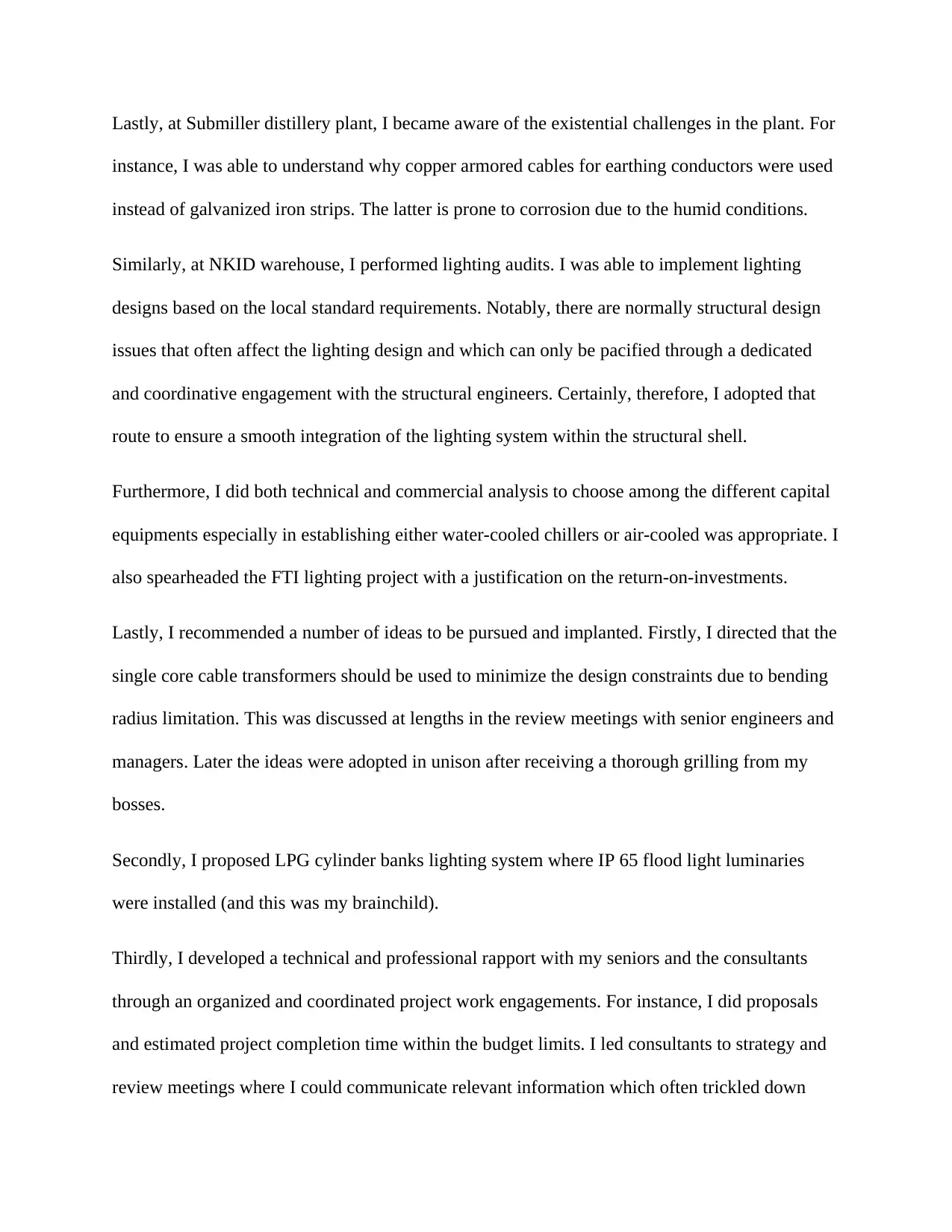
Lastly, at Submiller distillery plant, I became aware of the existential challenges in the plant. For
instance, I was able to understand why copper armored cables for earthing conductors were used
instead of galvanized iron strips. The latter is prone to corrosion due to the humid conditions.
Similarly, at NKID warehouse, I performed lighting audits. I was able to implement lighting
designs based on the local standard requirements. Notably, there are normally structural design
issues that often affect the lighting design and which can only be pacified through a dedicated
and coordinative engagement with the structural engineers. Certainly, therefore, I adopted that
route to ensure a smooth integration of the lighting system within the structural shell.
Furthermore, I did both technical and commercial analysis to choose among the different capital
equipments especially in establishing either water-cooled chillers or air-cooled was appropriate. I
also spearheaded the FTI lighting project with a justification on the return-on-investments.
Lastly, I recommended a number of ideas to be pursued and implanted. Firstly, I directed that the
single core cable transformers should be used to minimize the design constraints due to bending
radius limitation. This was discussed at lengths in the review meetings with senior engineers and
managers. Later the ideas were adopted in unison after receiving a thorough grilling from my
bosses.
Secondly, I proposed LPG cylinder banks lighting system where IP 65 flood light luminaries
were installed (and this was my brainchild).
Thirdly, I developed a technical and professional rapport with my seniors and the consultants
through an organized and coordinated project work engagements. For instance, I did proposals
and estimated project completion time within the budget limits. I led consultants to strategy and
review meetings where I could communicate relevant information which often trickled down
instance, I was able to understand why copper armored cables for earthing conductors were used
instead of galvanized iron strips. The latter is prone to corrosion due to the humid conditions.
Similarly, at NKID warehouse, I performed lighting audits. I was able to implement lighting
designs based on the local standard requirements. Notably, there are normally structural design
issues that often affect the lighting design and which can only be pacified through a dedicated
and coordinative engagement with the structural engineers. Certainly, therefore, I adopted that
route to ensure a smooth integration of the lighting system within the structural shell.
Furthermore, I did both technical and commercial analysis to choose among the different capital
equipments especially in establishing either water-cooled chillers or air-cooled was appropriate. I
also spearheaded the FTI lighting project with a justification on the return-on-investments.
Lastly, I recommended a number of ideas to be pursued and implanted. Firstly, I directed that the
single core cable transformers should be used to minimize the design constraints due to bending
radius limitation. This was discussed at lengths in the review meetings with senior engineers and
managers. Later the ideas were adopted in unison after receiving a thorough grilling from my
bosses.
Secondly, I proposed LPG cylinder banks lighting system where IP 65 flood light luminaries
were installed (and this was my brainchild).
Thirdly, I developed a technical and professional rapport with my seniors and the consultants
through an organized and coordinated project work engagements. For instance, I did proposals
and estimated project completion time within the budget limits. I led consultants to strategy and
review meetings where I could communicate relevant information which often trickled down
Paraphrase This Document
Need a fresh take? Get an instant paraphrase of this document with our AI Paraphraser
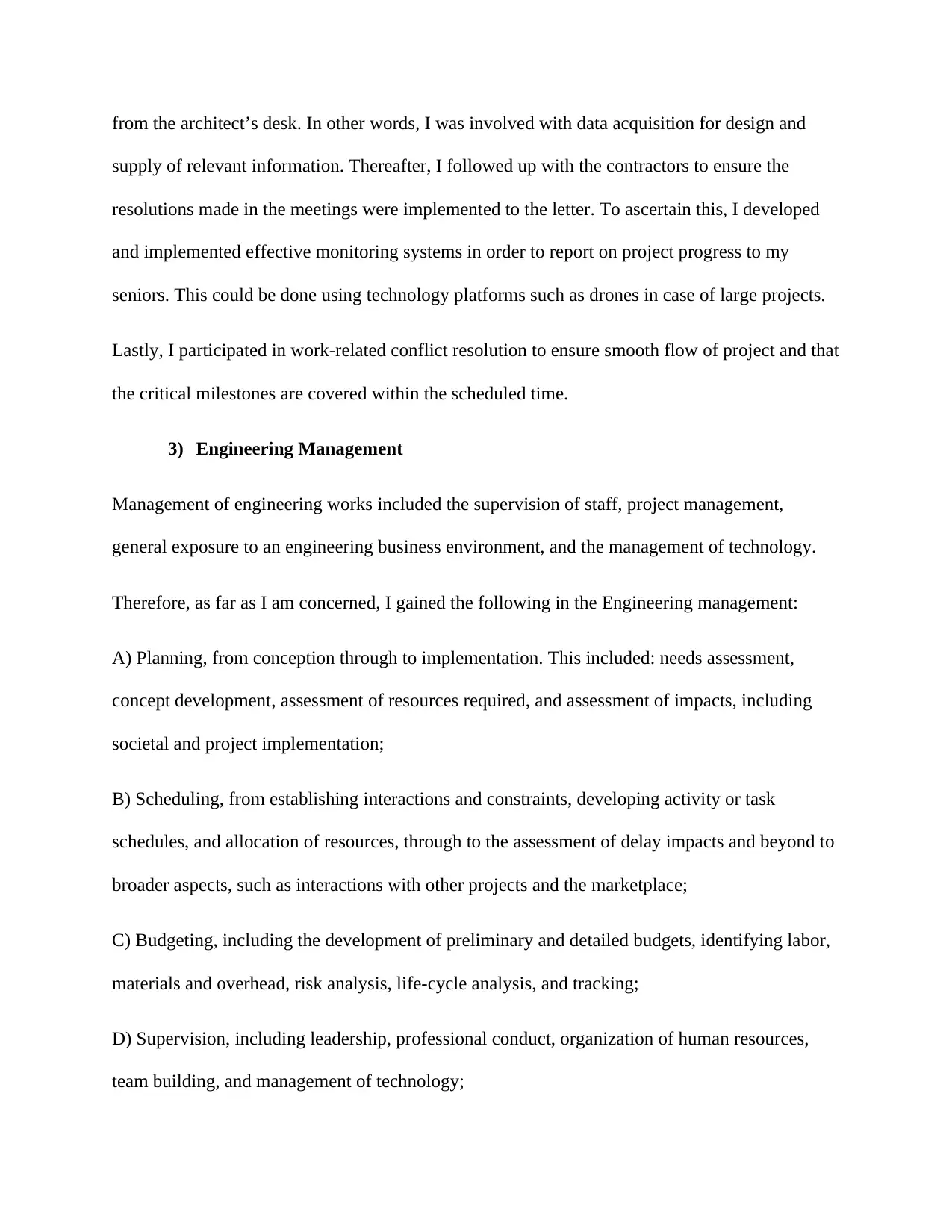
from the architect’s desk. In other words, I was involved with data acquisition for design and
supply of relevant information. Thereafter, I followed up with the contractors to ensure the
resolutions made in the meetings were implemented to the letter. To ascertain this, I developed
and implemented effective monitoring systems in order to report on project progress to my
seniors. This could be done using technology platforms such as drones in case of large projects.
Lastly, I participated in work-related conflict resolution to ensure smooth flow of project and that
the critical milestones are covered within the scheduled time.
3) Engineering Management
Management of engineering works included the supervision of staff, project management,
general exposure to an engineering business environment, and the management of technology.
Therefore, as far as I am concerned, I gained the following in the Engineering management:
A) Planning, from conception through to implementation. This included: needs assessment,
concept development, assessment of resources required, and assessment of impacts, including
societal and project implementation;
B) Scheduling, from establishing interactions and constraints, developing activity or task
schedules, and allocation of resources, through to the assessment of delay impacts and beyond to
broader aspects, such as interactions with other projects and the marketplace;
C) Budgeting, including the development of preliminary and detailed budgets, identifying labor,
materials and overhead, risk analysis, life-cycle analysis, and tracking;
D) Supervision, including leadership, professional conduct, organization of human resources,
team building, and management of technology;
supply of relevant information. Thereafter, I followed up with the contractors to ensure the
resolutions made in the meetings were implemented to the letter. To ascertain this, I developed
and implemented effective monitoring systems in order to report on project progress to my
seniors. This could be done using technology platforms such as drones in case of large projects.
Lastly, I participated in work-related conflict resolution to ensure smooth flow of project and that
the critical milestones are covered within the scheduled time.
3) Engineering Management
Management of engineering works included the supervision of staff, project management,
general exposure to an engineering business environment, and the management of technology.
Therefore, as far as I am concerned, I gained the following in the Engineering management:
A) Planning, from conception through to implementation. This included: needs assessment,
concept development, assessment of resources required, and assessment of impacts, including
societal and project implementation;
B) Scheduling, from establishing interactions and constraints, developing activity or task
schedules, and allocation of resources, through to the assessment of delay impacts and beyond to
broader aspects, such as interactions with other projects and the marketplace;
C) Budgeting, including the development of preliminary and detailed budgets, identifying labor,
materials and overhead, risk analysis, life-cycle analysis, and tracking;
D) Supervision, including leadership, professional conduct, organization of human resources,
team building, and management of technology;
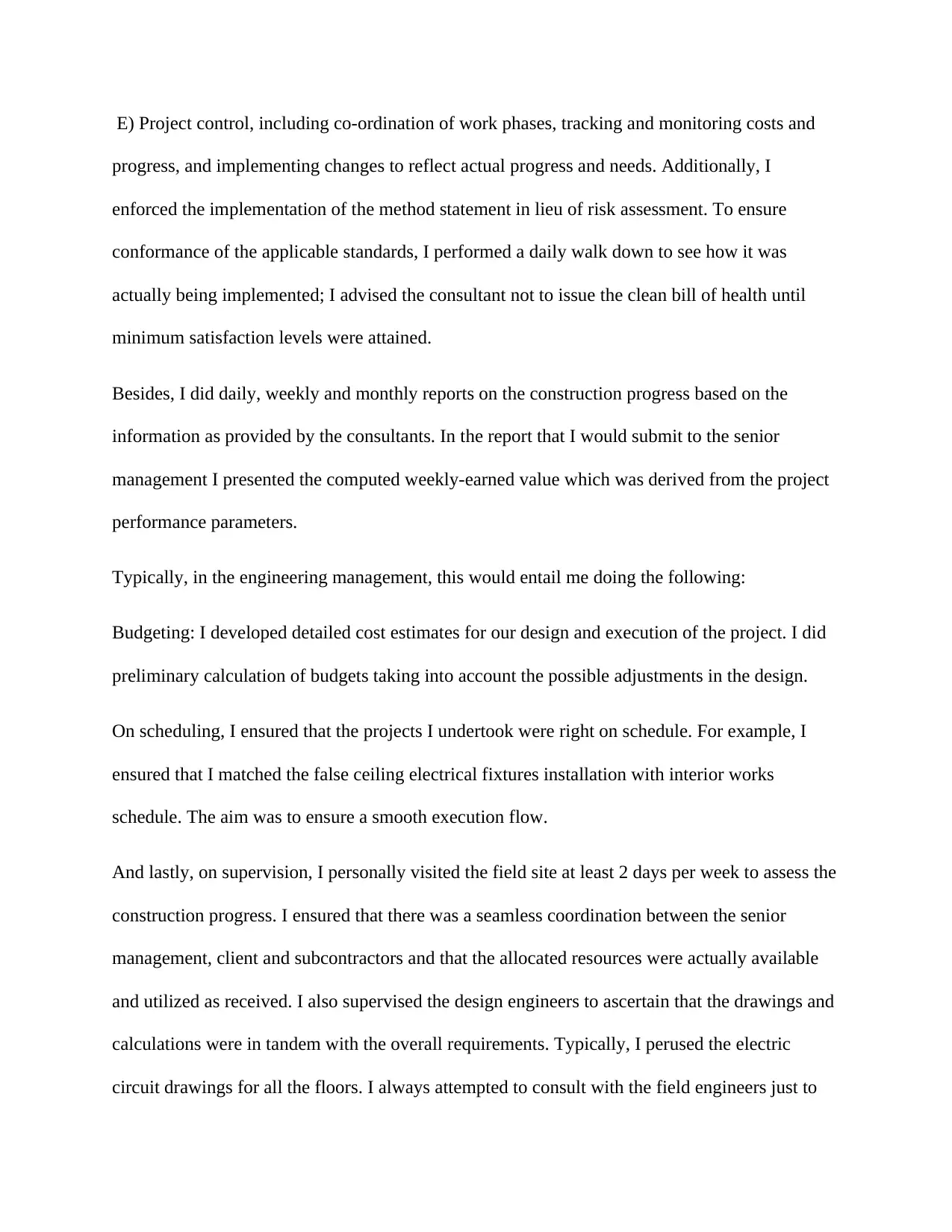
E) Project control, including co-ordination of work phases, tracking and monitoring costs and
progress, and implementing changes to reflect actual progress and needs. Additionally, I
enforced the implementation of the method statement in lieu of risk assessment. To ensure
conformance of the applicable standards, I performed a daily walk down to see how it was
actually being implemented; I advised the consultant not to issue the clean bill of health until
minimum satisfaction levels were attained.
Besides, I did daily, weekly and monthly reports on the construction progress based on the
information as provided by the consultants. In the report that I would submit to the senior
management I presented the computed weekly-earned value which was derived from the project
performance parameters.
Typically, in the engineering management, this would entail me doing the following:
Budgeting: I developed detailed cost estimates for our design and execution of the project. I did
preliminary calculation of budgets taking into account the possible adjustments in the design.
On scheduling, I ensured that the projects I undertook were right on schedule. For example, I
ensured that I matched the false ceiling electrical fixtures installation with interior works
schedule. The aim was to ensure a smooth execution flow.
And lastly, on supervision, I personally visited the field site at least 2 days per week to assess the
construction progress. I ensured that there was a seamless coordination between the senior
management, client and subcontractors and that the allocated resources were actually available
and utilized as received. I also supervised the design engineers to ascertain that the drawings and
calculations were in tandem with the overall requirements. Typically, I perused the electric
circuit drawings for all the floors. I always attempted to consult with the field engineers just to
progress, and implementing changes to reflect actual progress and needs. Additionally, I
enforced the implementation of the method statement in lieu of risk assessment. To ensure
conformance of the applicable standards, I performed a daily walk down to see how it was
actually being implemented; I advised the consultant not to issue the clean bill of health until
minimum satisfaction levels were attained.
Besides, I did daily, weekly and monthly reports on the construction progress based on the
information as provided by the consultants. In the report that I would submit to the senior
management I presented the computed weekly-earned value which was derived from the project
performance parameters.
Typically, in the engineering management, this would entail me doing the following:
Budgeting: I developed detailed cost estimates for our design and execution of the project. I did
preliminary calculation of budgets taking into account the possible adjustments in the design.
On scheduling, I ensured that the projects I undertook were right on schedule. For example, I
ensured that I matched the false ceiling electrical fixtures installation with interior works
schedule. The aim was to ensure a smooth execution flow.
And lastly, on supervision, I personally visited the field site at least 2 days per week to assess the
construction progress. I ensured that there was a seamless coordination between the senior
management, client and subcontractors and that the allocated resources were actually available
and utilized as received. I also supervised the design engineers to ascertain that the drawings and
calculations were in tandem with the overall requirements. Typically, I perused the electric
circuit drawings for all the floors. I always attempted to consult with the field engineers just to
⊘ This is a preview!⊘
Do you want full access?
Subscribe today to unlock all pages.

Trusted by 1+ million students worldwide

ensure that all requirements were followed to the letter and that the project completion deadline
was not crossed.
F) Risk-analysis related to operating equipment and system performance, product performance
evaluation, and evaluation of societal and environmental impacts.
4) Social Implications of Engineering
It is also imperative as an Engineer to be on the know of what impact the engineering project
work can have on the society. More often, Engineers work towards the betterment of society.
However, in the process of discharging our professional responsibilities; and even after project
completion, there are fundamental issues that arise as a result of our actions. As an electrical
Engineer, I have been aware of these issues. In fact, public safety is so critical that an entire
engineering project can be cancelled if found to be a greater risk to the safety of the public. In
one of the projects I was engaged in, where nuclear power plant project was to be launched in the
area. The community violently opposed the idea. Admittedly, we were in the process of
undertaking a feasibility study. In fact, after the study, the project was stalled to address the
issues that were identified in the feasibility report that our team presented to the authorities.
Therefore, I discovered that the overriding objective of the “social implications of engineering”
requirement is to provide experiences which increase awareness of an engineer's professional
responsibility is to guard against conditions dangerous or threatening to life, limb, property, or
the environment, and to call any such conditions to the attention of those responsible. The social
implications of engineering are an important aspect of the practice of engineering. The work
environment should provide opportunities for engineers to heighten their awareness of the
potential consequences of engineering work. Notably, in a nutshell, thisincluded:
was not crossed.
F) Risk-analysis related to operating equipment and system performance, product performance
evaluation, and evaluation of societal and environmental impacts.
4) Social Implications of Engineering
It is also imperative as an Engineer to be on the know of what impact the engineering project
work can have on the society. More often, Engineers work towards the betterment of society.
However, in the process of discharging our professional responsibilities; and even after project
completion, there are fundamental issues that arise as a result of our actions. As an electrical
Engineer, I have been aware of these issues. In fact, public safety is so critical that an entire
engineering project can be cancelled if found to be a greater risk to the safety of the public. In
one of the projects I was engaged in, where nuclear power plant project was to be launched in the
area. The community violently opposed the idea. Admittedly, we were in the process of
undertaking a feasibility study. In fact, after the study, the project was stalled to address the
issues that were identified in the feasibility report that our team presented to the authorities.
Therefore, I discovered that the overriding objective of the “social implications of engineering”
requirement is to provide experiences which increase awareness of an engineer's professional
responsibility is to guard against conditions dangerous or threatening to life, limb, property, or
the environment, and to call any such conditions to the attention of those responsible. The social
implications of engineering are an important aspect of the practice of engineering. The work
environment should provide opportunities for engineers to heighten their awareness of the
potential consequences of engineering work. Notably, in a nutshell, thisincluded:
Paraphrase This Document
Need a fresh take? Get an instant paraphrase of this document with our AI Paraphraser
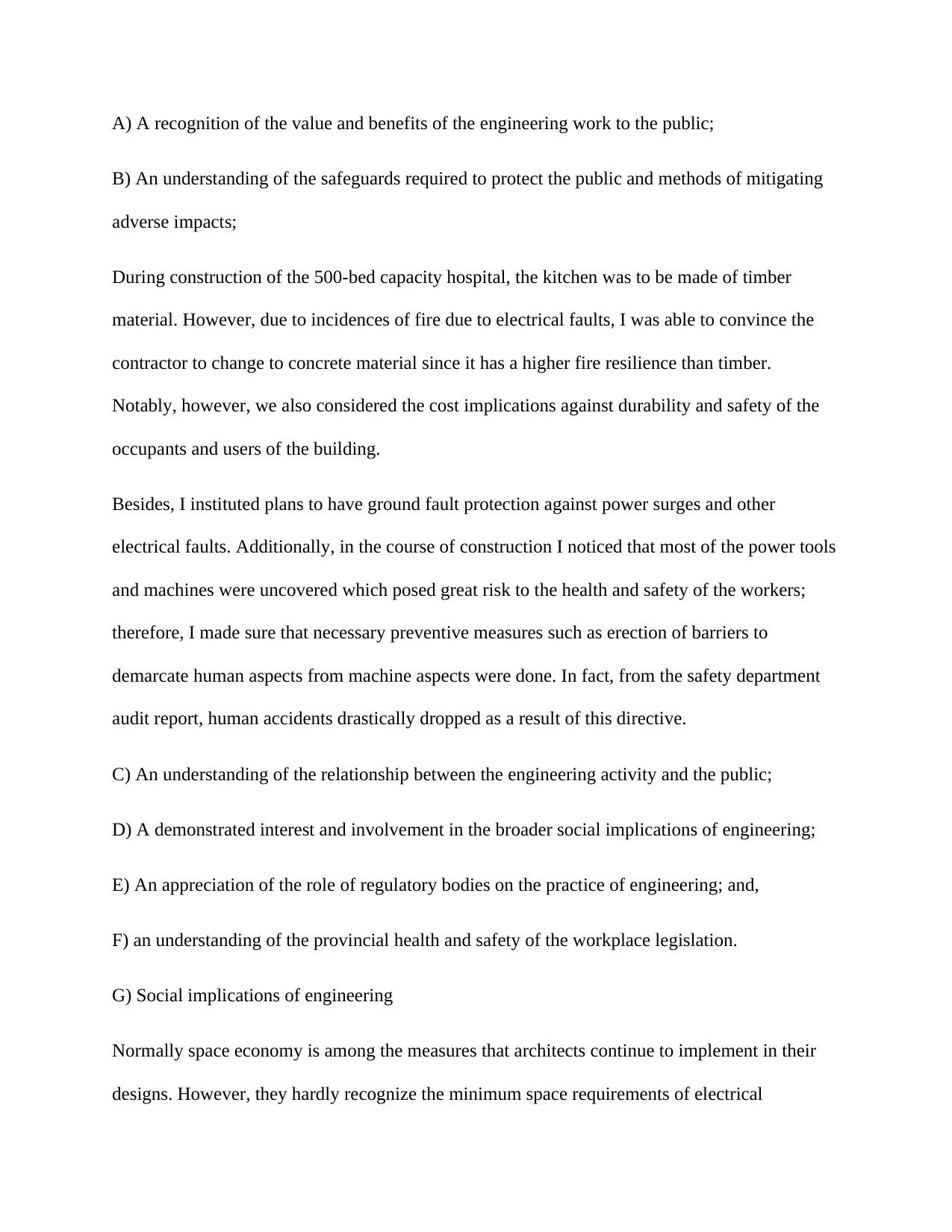
A) A recognition of the value and benefits of the engineering work to the public;
B) An understanding of the safeguards required to protect the public and methods of mitigating
adverse impacts;
During construction of the 500-bed capacity hospital, the kitchen was to be made of timber
material. However, due to incidences of fire due to electrical faults, I was able to convince the
contractor to change to concrete material since it has a higher fire resilience than timber.
Notably, however, we also considered the cost implications against durability and safety of the
occupants and users of the building.
Besides, I instituted plans to have ground fault protection against power surges and other
electrical faults. Additionally, in the course of construction I noticed that most of the power tools
and machines were uncovered which posed great risk to the health and safety of the workers;
therefore, I made sure that necessary preventive measures such as erection of barriers to
demarcate human aspects from machine aspects were done. In fact, from the safety department
audit report, human accidents drastically dropped as a result of this directive.
C) An understanding of the relationship between the engineering activity and the public;
D) A demonstrated interest and involvement in the broader social implications of engineering;
E) An appreciation of the role of regulatory bodies on the practice of engineering; and,
F) an understanding of the provincial health and safety of the workplace legislation.
G) Social implications of engineering
Normally space economy is among the measures that architects continue to implement in their
designs. However, they hardly recognize the minimum space requirements of electrical
B) An understanding of the safeguards required to protect the public and methods of mitigating
adverse impacts;
During construction of the 500-bed capacity hospital, the kitchen was to be made of timber
material. However, due to incidences of fire due to electrical faults, I was able to convince the
contractor to change to concrete material since it has a higher fire resilience than timber.
Notably, however, we also considered the cost implications against durability and safety of the
occupants and users of the building.
Besides, I instituted plans to have ground fault protection against power surges and other
electrical faults. Additionally, in the course of construction I noticed that most of the power tools
and machines were uncovered which posed great risk to the health and safety of the workers;
therefore, I made sure that necessary preventive measures such as erection of barriers to
demarcate human aspects from machine aspects were done. In fact, from the safety department
audit report, human accidents drastically dropped as a result of this directive.
C) An understanding of the relationship between the engineering activity and the public;
D) A demonstrated interest and involvement in the broader social implications of engineering;
E) An appreciation of the role of regulatory bodies on the practice of engineering; and,
F) an understanding of the provincial health and safety of the workplace legislation.
G) Social implications of engineering
Normally space economy is among the measures that architects continue to implement in their
designs. However, they hardly recognize the minimum space requirements of electrical
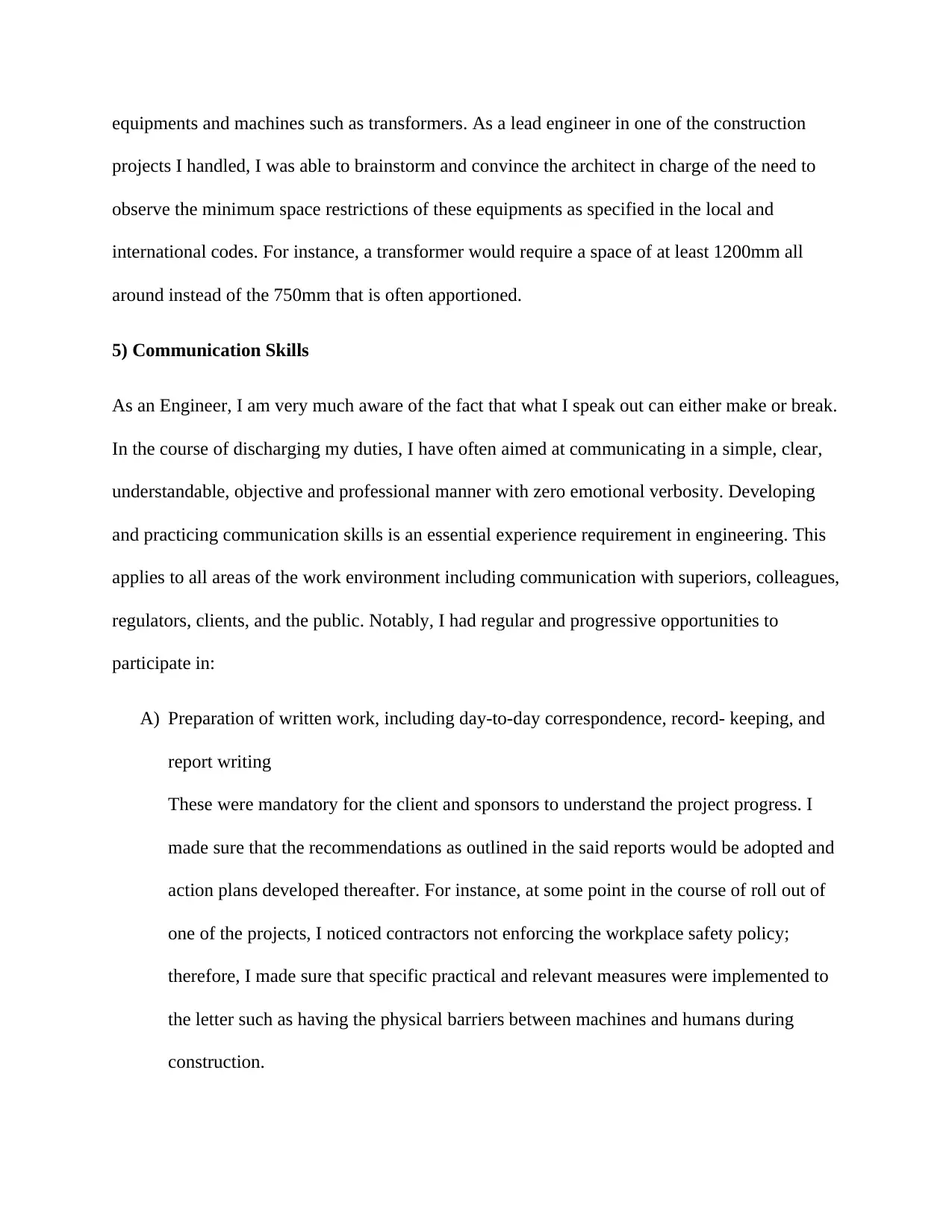
equipments and machines such as transformers. As a lead engineer in one of the construction
projects I handled, I was able to brainstorm and convince the architect in charge of the need to
observe the minimum space restrictions of these equipments as specified in the local and
international codes. For instance, a transformer would require a space of at least 1200mm all
around instead of the 750mm that is often apportioned.
5) Communication Skills
As an Engineer, I am very much aware of the fact that what I speak out can either make or break.
In the course of discharging my duties, I have often aimed at communicating in a simple, clear,
understandable, objective and professional manner with zero emotional verbosity. Developing
and practicing communication skills is an essential experience requirement in engineering. This
applies to all areas of the work environment including communication with superiors, colleagues,
regulators, clients, and the public. Notably, I had regular and progressive opportunities to
participate in:
A) Preparation of written work, including day-to-day correspondence, record- keeping, and
report writing
These were mandatory for the client and sponsors to understand the project progress. I
made sure that the recommendations as outlined in the said reports would be adopted and
action plans developed thereafter. For instance, at some point in the course of roll out of
one of the projects, I noticed contractors not enforcing the workplace safety policy;
therefore, I made sure that specific practical and relevant measures were implemented to
the letter such as having the physical barriers between machines and humans during
construction.
projects I handled, I was able to brainstorm and convince the architect in charge of the need to
observe the minimum space restrictions of these equipments as specified in the local and
international codes. For instance, a transformer would require a space of at least 1200mm all
around instead of the 750mm that is often apportioned.
5) Communication Skills
As an Engineer, I am very much aware of the fact that what I speak out can either make or break.
In the course of discharging my duties, I have often aimed at communicating in a simple, clear,
understandable, objective and professional manner with zero emotional verbosity. Developing
and practicing communication skills is an essential experience requirement in engineering. This
applies to all areas of the work environment including communication with superiors, colleagues,
regulators, clients, and the public. Notably, I had regular and progressive opportunities to
participate in:
A) Preparation of written work, including day-to-day correspondence, record- keeping, and
report writing
These were mandatory for the client and sponsors to understand the project progress. I
made sure that the recommendations as outlined in the said reports would be adopted and
action plans developed thereafter. For instance, at some point in the course of roll out of
one of the projects, I noticed contractors not enforcing the workplace safety policy;
therefore, I made sure that specific practical and relevant measures were implemented to
the letter such as having the physical barriers between machines and humans during
construction.
⊘ This is a preview!⊘
Do you want full access?
Subscribe today to unlock all pages.

Trusted by 1+ million students worldwide
1 out of 13
Related Documents
Your All-in-One AI-Powered Toolkit for Academic Success.
+13062052269
info@desklib.com
Available 24*7 on WhatsApp / Email
![[object Object]](/_next/static/media/star-bottom.7253800d.svg)
Unlock your academic potential
Copyright © 2020–2025 A2Z Services. All Rights Reserved. Developed and managed by ZUCOL.





